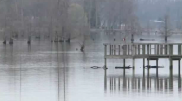Gulf War Oil Disaster: A Brief History
At the end of January 1991, reports of a huge oil spill in the Persian Gulf began to surface. Iraqi forces purposefully opened valves at the Sea Island oil terminal and dumped oil from several tankers into the Persian Gulf in a strategic wartime move against U.S. forces.
The U.S. accused the Iraqis of committing “environmental terrorism” by intentionally spilling several million barrels of oil. Administration sources also commented that an incendiary strike could be carried out against the spill, in an effort to burn oil before it reached key industrial facilities, including water purification plants, in the area. Iraqi officials blamed the U.S. for starting the spill via a recent bombing, however American officials denied the claim, as spilling oil didn't “do anything militarily.”
In a disaster already nearly inaccessible due to the war zone surrounding it, February's cleanup efforts to slow the effect of the spill were further hampered by poor coordination and lack of accessible funds. Alleged bureaucratic friction is said to have further exasperated efforts, however Saudi officials were quick to maintain that the situation was under control, reports The New York Times.
Southerly winds kept the 60-mile-long slick in place, but environmentalists were concerned that no preventative measures took place.
On March 2, Dr. Abdulbar Al Gain of the Saudi Arabian Meteorology and Environmental Protection Administration assured the public that the Arabian Gulf “has not been destroyed environmentally” but they conceded that it would probably take years for the environment to return to its natural state. Estimated spillage remained speculative, and reports decreased the amount of oil to 3 million barrels. Al Gain confirmed that the oil unleashed served no military purpose, as “only the environment suffers.”
Although the area surrounding Gulf War Oil Spill was finally cleared of strife relating to the war, the cleanup response remained slow-going. At an environmental conference between U.S. and Saudi officials on March 7, some commented that the amount of labor required to handle a disaster of its size was not available in the region, due to reconstruction efforts related to the war.
The Coast Guard commented that people who had seen the oil were “amazed” at the amount, however estimates still remained wildly speculative.
Meanwhile, the Kuwaiti Oil Fires blazed. Red Adair, legendary oil well firefighter, complained about the lack of a reliable chain of command while fighting the fires.
The firefighting team started in the northeastern region of wells and planned to move toward the larger, more unwieldy fires of the southwest. At that point, 175 of an estimated 500 fiery wells were controlled, however Adair said the process would be more effective if the Kuwaiti Oil Co. did not put bids out for equipment needed.
The oceanic oil slick inched toward containment. Confident that most of the oil that had accumulated in the water was dissipated, Saudi Arabia began to put away serpentine booms that had been used as shields from contamination. Some booms would still remain around water filtering and desalination plants. Although the amount spilled was still unknown at that point, at least 2 million barrels of “weathered” oil had been accumulated. Twenty-one skimming boats had also been deployed to the region, in order to search for oil patches.
Paul Horsman, a Greenpeace activist, surveyed 240 miles of Persian Gulf shoreline before telling the Chicago Sun-Times that some parts were “beyond repair.”
Saudi officials announced that beach cleanup response would start in September, saying that over 1.7 million barrels had already been removed from the sea. Horsman was doubtful that the cleanup would make a difference as he said most areas were beyond recovery due to the delay.
All oil wells damaged due to the Gulf War were officially shut down on November 7. Burgan 118, an oil well specifically reignited for the event, was ceremoniously shut down by Sheik Jaber al-Ahmed al-Sabah, the emir of Kuwait. The oil minister proclaimed that the natural resources of the area were officially protected and a full ecological survey was still being carried out. The ceremony included musical accompaniments of bagpipes and tambourines, and the emir walked down a red carpet to shut down the well.
The cost of dousing the Kuwaiti oil fires amounted to more than $1.5 billion. More than 700 wells were capped, and firefighters used over a billion gallons of water to put out the oil fires.
Even so, over 200 lakes of oil formed throughout the desert due to the massive amounts of spillage, some more than 6 feet deep. By the end of 1991, the massive cloud of smoke that had formed during the fires was starting to dissipate, but many in the local population continued to complain of respiratory problems.
As of March 2011, cleanup is far form over. According to Arab News, the Saudi government set contracts worth 700 million Saudi Riyal (over $180 million) to rehabilitate the environments decimated by the Gulf War. The UN contributed $45 million.





